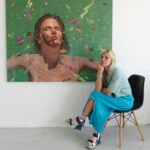Boundless Shapes and Infinite Paths – Robert Straight’s Art of Geometric Discovery

A masterful artist explores prime numbers and grids to capture the infinite
Robert Straight discusses his dynamic exploration of geometric forms and structured grids, blending abstraction with conceptual depth through prime numbers, unique canvases, and infinite motifs that embody his lifelong creative evolution.
For over six decades, Robert Straight has journeyed through the rich terrains of abstraction, guided by his fascination with geometric form and structure. Known for his intricate compositions that bridge the realms of geometry and abstract expression, Straight’s work presents a profound exploration of infinity, order, and space. His pieces often transcend the conventional limits of a rectangular canvas, embracing irregular, shaped formats that echo the organic complexity of mathematical systems and the boundless possibilities they inspire. Straight’s art is celebrated not only for its aesthetic strength but also for its intellectual depth, weaving together ideas from prime numbers, the infinite repetition of grids, and the ethereal spirals found in nature.
In this exclusive interview with WOWwArt Magazine, Robert Straight opens up about his career-long evolution with geometry, shaped canvases, and his search for abstract infinity in art. With inspirations spanning from Brancusi’s “Endless Column” to the meditative structure of canvas weaves, Straight shares how each choice—be it shape, structure, or sequence—reflects a personal philosophy deeply rooted in observation, curiosity, and a lifetime of artistic discovery. Join us as we delve into the mind of an artist who continues to redefine abstraction with a passion that remains, even now, undimmed.
Robert Straight’s work transcends traditional boundaries, merging intellectual rigor with bold abstraction to create compositions that captivate with depth and precision.
How has your understanding of geometric forms evolved throughout your artistic career?
I made a decision after I completed my undergraduate degree that representational art was best made with a camera. I was still interested in painting, so abstraction and ultimately geometry was a result of this decision. At the beginning of this 65 year adventure I have developed more personal thoughts about geometry and number sequences. I was terrible math student so it’s surprising that it has become a huge part of my artistic work.
Can you elaborate on the relationship between the interior structure of your paintings and their exterior shapes?
I continue to work with both the conventional rectangle as well as shaped formats. Each offers diverse possibilities and challenges. The exterior of my shaped paintings come first and the interior structure is a response to the shape of this substrate. These works are more involved with the actual physical construction of the structure. The rectangular format offers a more neutral arena with unlimited possibilities.
What challenges and opportunities do you find in using both conventional rectangular formats and shaped formats in your work?
Each format makes me think in different ways, it throws me a bit off balance and keeps me thinking in unexpected ways.
How do prime numbers influence your artistic process, and what significance do they hold in your geometric constructions?
Prime numbers give me a base to use in my work. The fact that they are finite is important. Most of the time I use prime numbered sections of circles or for the division of the rectangle. I’m interested in oppositions in my work, inside/outside, infinite/finite, positive/negative etc.
In what ways has Brancusi’s Endless Column inspired your exploration of repetition and infinity in your work?
The form that Brancusi used to suggest the endless repetition to move into space forever is anamazing innovation to me. Again the infinite, finite comes into play. Expansion or infinitestructure is also suggested in my use of the grid.
How do you decide when to use uniform versus less uniform grids in your paintings, and what impact does this choice have on your overall composition?
Originally the weave of the canvas got me thinking about the grid as an infinite structure. If a loom were large enough it could make this material expand forever. Again, my obsession with the infinite. The grid also suggests plaids. Plaids still use the structure of the grid but in a different manner.
After working in the studio for over 60 years, I feel like I’m still exploring the endless possibilities that my main focus, painting, offers. My studio activities are affected by my gardening, food, music, car colors, numbers, and other everyday observations. This exploration has led me to work in clay, sculpture, printmaking, and drawing, at times combining several of these disciplines. My work can have three dimensional formats informed by surfboards, while other work uses the more conventional rectangular format. I’m still excited by what happens in my studio. Lately, I’ve been waking up at night thinking about possibilities that can move my work forward. Simple things like “what is a line”, “what is grey”, “why do I prefer a vertical orientation in my work ”. I grew up in Kansas, Texas and Southern California. Grad school in Michigan, first teaching job in Atlanta, then Connecticut, and finally Delaware where I reside with my best friend and wife.
EDITOR’S HIGHLIGHTS
Empowering Art & Artists Globally
“Being featured in WOWwART means gaining visibility not just in print edition, but across the entire media spectrum in the US, UK, Europe and beyond”

EDITOR’S HIGHLIGHTS
Media, Art and Artist
Media is a powerful tool to build relationships, boost visibility, influence decisions, and create lasting impressions for success and growth.













